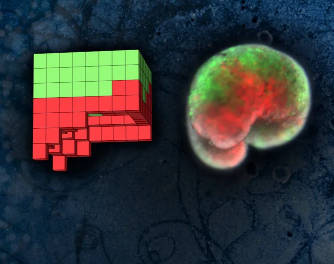| First Living Robots Constructed |
| Written by Mike James | |||
| Saturday, 08 February 2020 | |||
|
Cells are the building blocks of animals so why not repurpose them to create machines that do predetermined jobs? That's what a team at the University of Vermont has done to create xenobots. Take the cells that would turn into a frog's skin and some others that would turn into a frog's heart and culture them. Next take the known properties of the cells and use a supercomputer to simulate assemblies of cells of different types. Use this to implement a genetic programming approach to refining the initial design to create an assemblage the does what you want. The final step is to give the design to a microsurgeon who can take the cells and form the shape by cutting and joining. The result is a xenobot - so called because the frogs used are Xenopus laevis and xeno means "other" or "strange" which seems appropriate.
On the left the design on the right the implementation The design target was to create something that moved by "walking". Heart muscles have a tendency to contract in waves and this is what makes the walking action. You can see that it seems to work. The small blob, just 0.7 millimeters across and made of around 5000 cells, moves slowly. (The video is speeded up by a factor of 4): These xenobots live in fresh water and they don't eat. They survive on stored energy and die after about seven days. They don't reproduce, but they can repair themselves if injured. They are assemblies of frog cells, but clearly they are not frogs. They are not like any natural organism. Later xenobots were designed to swim, push and carry things and it is suggested that one day they might do something really useful like unblock an artery say. Apart from being potentially useful, biological robots are a way of finding out how cells organize. We may know a lot about DNA and how its program creates different proteins on demand, but we don't know very much about how cells organize and work together. Putting them together in artificial assemblies could provide ways to explore and test ideas. You can find the program to do the designing on GitHub and try creating your own xenobots. However, actually fabricating them is another difficult challenge, unless you have the skills of a microsurgeon. More InformationA scalable pipeline for designing reconfigurable organisms Sam Kriegman, Douglas Blackiston, Michael Levin, and Josh Bongard Related ArticlesE.coli Could Be Your Next Raspberry Pi E. coli Your Next Major Platform Programmed In Cello Traveling Salesman Applied To DNA Synthesis Book Stored On DNA - All Knowledge In Just 4gm of DNA A New DNA Sequence Search - Compressive Genomics Turing's Biological Pattern Theory Proved To be informed about new articles on I Programmer, sign up for our weekly newsletter, subscribe to the RSS feed and follow us on Twitter, Facebook or Linkedin.
Comments
or email your comment to: comments@i-programmer.info
|
|||
| Last Updated ( Saturday, 08 February 2020 ) |



